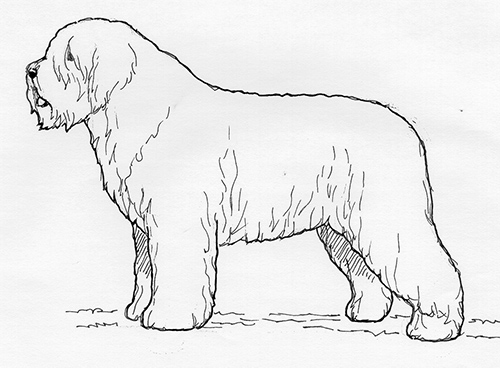South Russian Shepherd Dog
Herding Dog Group
The goals and purposes of this breed standard include: to furnish guidelines for breeders who wish to maintain the quality of their breed and to improve it; to advance this breed to a state of similarity throughout the world; and to act as a guide for judges.
Breeders and judges have the responsibility to avoid any conditions or exaggerations that are detrimental to the health, welfare, essence and soundness of this breed, and must take the responsibility to see that these are not perpetuated.
Any departure from the following should be considered a fault, and the seriousness with which the fault should be regarded should be in exact proportion to its degree and its effect upon the health and welfare of the dog and on the dog’s ability to perform its traditional work.
History
The history of the South Russian Shepherd Dog is shrouded in antiquity. There are many variations in the descriptions of their origin that are available. One thing seems certain; this is a native Russian breed, directly descended from the wolf, with additions of local shepherd dogs and sighthounds. They were used as flock herders and guardians in the Russian steppes.
The South Russian Shepherd Dog was originally recognized on January 1, 1996 by the United Kennel Club as the South Russian Ovcharka. Effective January 1, 2009, the breed name was changed to South Russian Shepherd Dog, and the breed moved from the Guardian Dog Group to the Herding Dog Group.
General Appearance
The South Russian Shepherd Dog is a dog of above average size and robust constitution, with a thick, dense, double coat. The breed is lean, but with massive bone structure and strongly developed musculature. Secondary sex characteristics are strongly marked, with the males being stronger, more massive and more courageous than the females.
Characteristics
Fierce, distrustful of strangers, and dominant in character, the South Russian Shepherd Dog is capable of adjusting to a wide variety of climatic conditions and temperatures.
Serious Faults: Uncontrolled excitability or cowardice.
Head
The head is elongated in shape, with a moderately broad forehead. In basic shape, it is similar to the wolf.
SKULL
The occipital crest and zygomatic arches are strongly developed. The stop is barely visible.
MUZZLE
The muzzle is approximately the same length as the skull, with a straight nasal bone and tight lips that are black and fully pigmented.
TEETH
The South Russian Shepherd Dog has a complete set of evenly spaced, white teeth meeting in a scissors bite.
Faults: Small teeth, lack of premolars.
Serious Fault: Any bite other than scissors.
NOSE
The nose is large and black.
Serious Fault: Pink nose.
EYES
The eyes are oval in shape, with dark, tight rims. They are set horizontally, and are dark in color.
Fault: Light eyes.
Serious Faults: Eyes of different colors, pink eyerims.
EARS
The ears are relatively small, triangular in shape, and hang close to the head.
Fault: Ears that lift away from the head.
Neck
The neck is moderately long, lean, muscular, and set high.
Forequarters
The angle formed by the shoulder blade and the upper arm is approximately 100 degrees.
FORELEGS
The forelegs are straight, parallel and relatively long. The pasterns are wide, long and slightly slanting.
Body
The body is slightly longer than tall. The chest is deep, reasonably broad and slightly flattened. The withers are apparent but not high. The back is straight and strong. The loin is short, broad and slightly arched. The belly is moderately tucked up.
Faults: Square in shape or excessively elongated. Weak or roach back. Chest not let down to elbow. Excessive tuck up or sagging flank.
Hindquarters
The hindquarters are powerful, wide set, parallel and well angulated.
HIND LEGS
The upper thigh is well muscled. The stifle is well angulated. The hock joint is clean cut and angular. The rear pastern is strong and long.
Feet
The feet are oval in shape, strong, well arched, and covered with long hair.
Tail
The tail falls at rest, reaching to the hock. It has a slight upward curve at the end.
Coat
The coat is long, coarse, thick and dense, with a well developed undercoat. It is of equal length on the head, legs, chest and tail.
Fault: Straight hair.
Serious Faults: Short coat, soft texture.
Color
White, white and yellow, straw colored, ashen grey and other shades of grey, white lightly marked with grey and grey speckled.
Serious Faults: Black, brown or any color not specifically stated in the standard. Strong speckling.
Height
Height for males is a minimum of 25 inches. For females, it is a minimum of 24 inches.
Serious Fault: Undersize.
Gait
The natural gaits of this breed are the heavy trot and the gallop. The gaits are free and extended. At a trot, the legs move in a straight line and tend to converge toward a center line.
Disqualifications
(A dog with a Disqualification must not be considered for placement in a conformation event, and must be reported to UKC.)
Unilateral or bilateral cryptorchid.
Viciousness or extreme shyness.
Albinism.

Looking for a Dog?
Find a dog that will fit your family.
Note: The breeders on this list are not endorsed by UKC.
Revised January 1, 2009
©Copyright 1996, United Kennel Club
